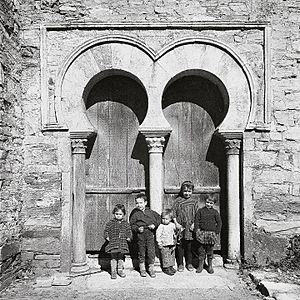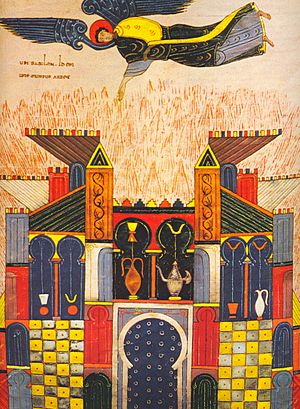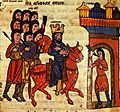Mozarabic art and architecture facts for kids
Mozarabic art is a special kind of art. It was made by people called Mozarabs. Mozarabs were Christians who lived in parts of Spain ruled by Muslims. This was from the year 711 until the late 1000s.
The word "Mozarab" comes from an Arabic word meaning "Arabized." These Christians adopted some Arab customs. But they kept their Christian faith. They also kept some of their own church and legal rules.
At first, "Mozarabic art" described art from all over Spain. Now, it usually refers to art, especially buildings, from the southern parts. Art from the north is often called Repoblación art and architecture.
Contents
Mozarabic Art: A Unique Style
Mozarabic communities often used old Visigothic churches. These churches were built before the Arab rule. It was hard for them to build new churches. Even though there was some religious tolerance, getting permission was tough. New churches were usually small and built in the countryside. Or they were built on the edges of cities.
When Christian kingdoms in northern Spain grew, some Mozarabs moved there. They were offered land. Their culture was a mix of old Spanish and Muslim ways. This mix likely helped shape the new cultures in the Christian kingdoms.
During the 9th century, a style called "Asturian art" developed in northern Spain. This art was part of a larger style called "Pre-Romanesque." It was made in the kingdom of Asturias. But art and building continued across northern Spain into the 10th century.
As the border between Christian and Muslim lands moved, new churches were needed. The northern kingdoms were strong enough to build these. They did not rely on the Mozarabs for all new art and buildings. Many Mozarabs were rural immigrants with limited resources.
In 1917, a scholar named Manuel Gómez Moreno wrote a book. He called the churches built in Christian lands from the late 800s to early 1000s "Mozarabic." This name became very popular. However, some experts later questioned if all these buildings were truly "Mozarabic." Today, many scholars prefer the term "Repoblación art and architecture" for this period. This is especially true for art in northern Spain.
Literature and Books
The most important Mozarabic writings were religious books. These included missals, antiphonaries, and prayer books. They were made in monasteries.
Some famous examples are illustrated books. These are called illuminated manuscripts. They have amazing drawings and paintings. One famous series is the Commentary on the Apocalypse by Beatus of Liébana. Other examples include the Beatus of Facundus and the Beatus of Tábara. There is also the Mozarabic Antiphonary of the Cathedral of León.
The cities of Toledo and Córdoba were important Mozarabic centers. From Córdoba, a leader named Speraindeo wrote a defense against Muhammad. Another important work was the Apologetic of the abbot Sansón from 864. This book is very helpful for studying the history of philosophy.
Architecture: Building Style
Mozarabic buildings have some key features:
- They used strong building techniques. They often used large, well-cut stones.
- The outside of the buildings was usually plain. There was not much decoration.
- The buildings had different floor plans. Many were small. They had separate spaces covered by domes. These domes could be groined, segmented, or ribbed.
- They often used a special kind of arch. This is called a horseshoe arch. It is very tight and rounded.
- They used a frame around the arch called an alfiz.
- Columns were used for support. These columns had Corinthian capitals. These capitals were decorated with simple plant designs.
- The roof edges stuck out. They rested on supports called corbels. These corbels often had a curved, lobed shape.
Strictly speaking, only two buildings are known to be built by Mozarabs in Muslim Spain:
- The Church of Bobastro: This was a rock temple in Ardales, Málaga. Only ruins remain today.
- The Church of Santa María de Melque: This church is near La Puebla de Montalbán (Toledo). Experts are not sure about its exact style or date. It has both old Visigothic and Mozarabic features.
However, many other important buildings in Spain and Portugal are commonly called Mozarabic. Some of these include:
- In Castile and León:
* San Miguel de Escalada (León) * Santiago de Peñalba (León) * Santo Tomás de las Ollas (León) * San Baudelio de Berlanga (Soria) * San Cebrián de Mazote (Valladolid) * Santa María de Wamba (Valladolid) * San Salvador de Tabara (Zamora)
- In Cantabria:
* Santa María de Lebeña (Cantabria)
- In Aragón:
* San Juan de la Peña (Huesca) * Churches of the Serrablo (Huesca), like the Church of San Juan de Busa
- In La Rioja:
* San Millán de Suso (San Millán de la Cogolla)
- In Catalonia:
* Sant Quirze de Pedret (Barcelona) * Santa Maria de Marquet (Barcelona) * Church of Sant Cristòfol (Barcelona), in Vilassar de Mar * Sant Julià de Boada (Girona), in Baix Empordà * Santa Maria de Matadars (Barcelona), in El Pont de Vilomara i Rocafort
- In Galicia:
* San Miguel de Celanova (Orense)
- In Portugal:
* São Pedro de Lourosa (Lourosa da Beira) * Catedral de Idanha-a-Velha (Idanha-a-Velha)
Gallery
-
San Baudelio de Berlanga, Soria.
-
Santa María de Lebeña, Cantabria.
-
San Juan de la Peña, Aragón
-
León Antiphonary Folio (11th century, León Cathedral)
-
Mozarabic arches of Santiago de Peñalba (León)
-
Inside of San Millán de Suso (La Rioja)
-
Santa María de Lebeña (Cantabria)
-
Painting: combat elephant, from San Baudelio de Berlanga (Soria)
-
Entry of Christ into Jerusalem, from San Baudelio de Berlanga (Soria), now in Indianapolis
-
Art from the Escorial Beatus
See also
 In Spanish: Arte mozárabe para niños
In Spanish: Arte mozárabe para niños














